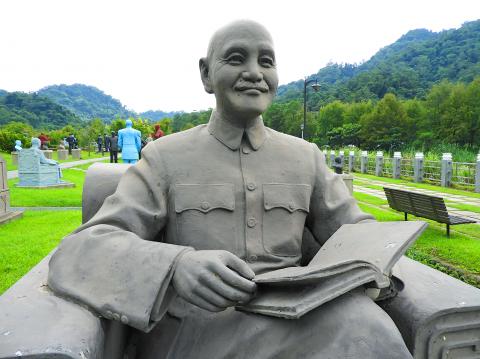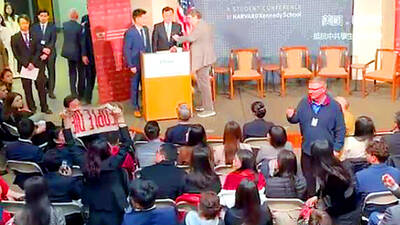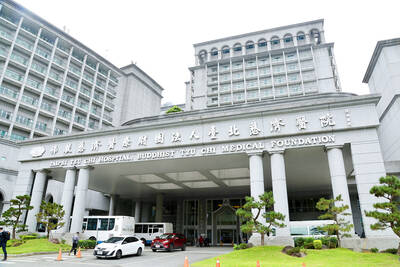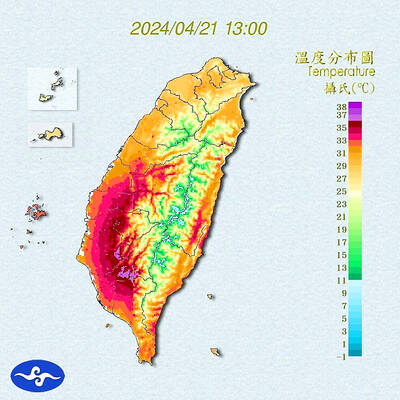New Power Party Legislator Hsu Yung-ming (徐永明) yesterday urged the Transitional Justice Commission to step up its handling of statues of Chiang Kai-shek (蔣介石) and other symbols of the authoritarian era.
While the commission has done well in exonerating victims of political persecution, it must also move forward with the removal or relocation of the many statues of Chiang across the nation, especially the largest one at the Chiang Kai-shek Memorial Hall, Hsu said.
Nationwide, there are 1,064 statues of Chiang Ka-shek and 1,010 other symbols of authoritarianism, as well as 577 places named after Chiang Kai-shek and his son Chiang Ching-kuo (蔣經國), the commission said.

Photo: Chen Yu-fu, Taipei Times
So far, 227 statues of Chiang Kai-shek have been relocated to the Cihu Mausoleum in Taoyuan where he is buried.
The other 837 can be found in schools, parks, traffic roundabouts, government buildings and veteran service facilities. Taipei leads with 129 statues of Chiang Kai-shek, followed by 111 in Taoyuan, 98 in Taichung, 82 in Kaohsiung, 45 in Hsinchu County, 40 in Pingtung County, 37 in Taitung County, 35 in Changhua County, 34 in New Taipei City, 30 in Hualien County, 29 in Yunlin County, 28 in Tainan, 25 in Chiayi County, 19 in Keelung, 16 each in Kinmen and Lienchiang County, 14 each in Hsinchu and Yilan counties, 13 in Miaoli County, 10 in Nantou County, 9 in Penghu County and 3 in Chiayi City, commission data showed.
Former Tainan mayor William Lai (賴清德) had ordered the removal of Chiang Kai-shek statues from the city while he was mayor, but 28 statues still remained, it said.
Chiayi City has the fewest Chiang Kai-shek statues, with only three, it said, adding that former mayor Twu Shiing-jer (涂醒哲) had one statue dismantled in 2015, saying it was a waste of police resources to protect it.
The statue, which was in the city’s Zhongzheng Park, was frequently vandalized.
One statue was found at the former Hsinchu Detention Center For Mainland Chinese, or so-called Ching-lu (靖廬), the commission said, adding that Chinese interns at the center were required to salute the statue.
The park is to be converted into a historical site in the future.
Among other symbols of authoritarianism are 104 paintings of Chiang Kai-shek and 31 paintings of Chiang Ching-kuo, the commission said.
The commission would need to clearly identify paintings and statues of Chiang Kai-shek and Chiang Ching-kuo as “symbols of authoritarianism” to overcome opposition to their removal by certain government agencies, Hsu said.
The commission must clearly state the demands of transitional justice when it faces opposition, he said.

A group of Taiwanese-American and Tibetan-American students at Harvard University on Saturday disrupted Chinese Ambassador to the US Xie Feng’s (謝鋒) speech at the school, accusing him of being responsible for numerous human rights violations. Four students — two Taiwanese Americans and two from Tibet — held up banners inside a conference hall where Xie was delivering a speech at the opening ceremony of the Harvard Kennedy School China Conference 2024. In a video clip provided by the Coalition of Students Resisting the CCP (Chinese Communist Party), Taiwanese-American Cosette Wu (吳亭樺) and Tibetan-American Tsering Yangchen are seen holding banners that together read:

UNAWARE: Many people sit for long hours every day and eat unhealthy foods, putting them at greater risk of developing one of the ‘three highs,’ an expert said More than 30 percent of adults aged 40 or older who underwent a government-funded health exam were unaware they had at least one of the “three highs” — high blood pressure, high blood lipids or high blood sugar, the Health Promotion Administration (HPA) said yesterday. Among adults aged 40 or older who said they did not have any of the “three highs” before taking the health exam, more than 30 percent were found to have at least one of them, Adult Preventive Health Examination Service data from 2022 showed. People with long-term medical conditions such as hypertension or diabetes usually do not

POLICE INVESTIGATING: A man said he quit his job as a nurse at Taipei Tzu Chi Hospital as he had been ‘disgusted’ by the behavior of his colleagues A man yesterday morning wrote online that he had witnessed nurses taking photographs and touching anesthetized patients inappropriately in Taipei Tzu Chi Hospital’s operating theaters. The man surnamed Huang (黃) wrote on the Professional Technology Temple bulletin board that during his six-month stint as a nurse at the hospital, he had seen nurses taking pictures of patients, including of their private parts, after they were anesthetized. Some nurses had also touched patients inappropriately and children were among those photographed, he said. Huang said this “disgusted” him “so much” that “he felt the need to reveal these unethical acts in the operating theater

Heat advisories were in effect for nine administrative regions yesterday afternoon as warm southwesterly winds pushed temperatures above 38°C in parts of southern Taiwan, the Central Weather Administration (CWA) said. As of 3:30pm yesterday, Tainan’s Yujing District (玉井) had recorded the day’s highest temperature of 39.7°C, though the measurement will not be included in Taiwan’s official heat records since Yujing is an automatic rather than manually operated weather station, the CWA said. Highs recorded in other areas were 38.7°C in Kaohsiung’s Neimen District (內門), 38.2°C in Chiayi City and 38.1°C in Pingtung’s Sandimen Township (三地門), CWA data showed. The spell of scorching